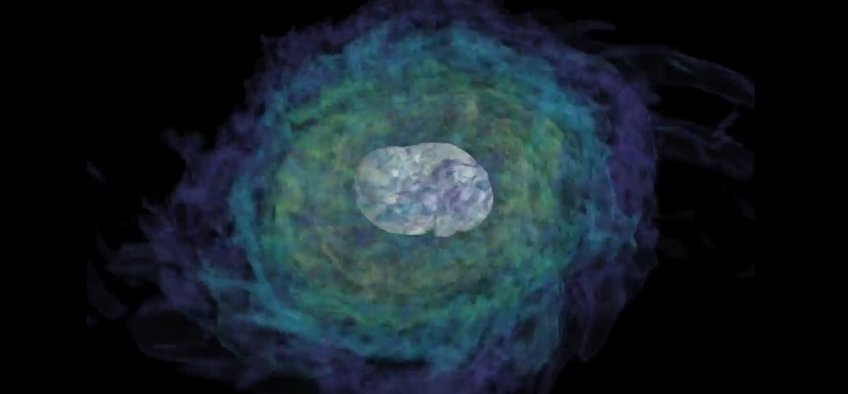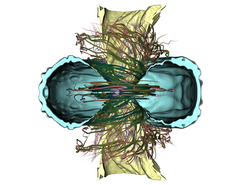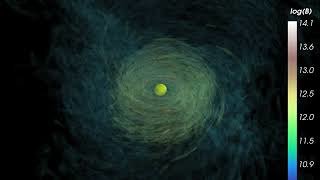
Binary neutron stars: inspiral and merger
Neutron star merger visualized
This video shows a computer simulation of two neutron stars merging, showing threedimensional visualizations of the data. The simulation models an event like the one responsible for the first gravitational waves detected by LIGO and Virgo in 2017 from a neutron star coalescence (GW170817).
The scientific details are described in the publication: W. Kastaun and F. Ohme, “Numerical inside view of hypermassive remnant models for GW170817”, Phys. Rev. D 104 (2021)
The video shows research done by the research group “Binary Merger Observations and Numerical Relativity” at the Max Planck Institute for Gravitational Physics (Albert Einstein Institute, AEI) Hannover
Simulations and raytracing performed on the “Holodeck” cluster at AEI by Wolfgang Kastaun.
Extra credits: thanks to the SOHO observatory for images of the sun, to “Smarter Every Day” for the slow motion bird footage, and to the developers of Blender, the free open source raytracing software.
Neutron star merger visualized
Binary neutron star merger (with magnetic fields)
This movie shows the final stages of the coalescence and the merging of two neutron stars. Neutron stars are dense objects created in certain supernova explosions, and concentrate around 1.5 solar masses inside a radius less than 20 km. Further, they can have extreme magnetic fields. The merging of two neutron stars is believed to be the source of the frequently observed so-called short gamma ray bursts, and is also the most likely source for the creation of heavy elements in the universe, such as gold.
In the movie, the white solid surfaces depict the surfaces of the two neutron stars and the merged object. The latter collapses to a black hole after a while, shown in yellow for better visibility. Afterwards, various amplification effects create strong magnetic fields near the black hole, shown as transparent colors. The magnetic field likely plays a key role in the gamma-ray emission, but the exact mechanism is still a field of active research, in particular with the help of computer simulations such as the one this movie is based on.
This movie is based on the simulations described in T. Kawamura, B. Giacomazzo, W. Kastaun, R. Ciolfi, A. Endrizzi, L. Baiotti, and R. Perna, “Binary neutron star mergers and short gamma-ray bursts: Effects of magnetic field orientation, equation of state, and mass ratio”, Phys. Rev. D 94, 064012 (2016)
Note: Publication of these images and movie requires proper credits and written permission. Please contact the AEI press office in advance of publication or for higher-resolution versions.
Acknowledgements:
These results were obtained with the help of the following grants: PRACE grant GRSimStar (PI Giacomazzo), MIUR FIR grant No. RBFR13QJYF (PI Giacomazzo)
Credit:
Visualisation: W. Kastaun (University of Trento and Max Planck Institute for Gravitational Physics)
Numerical relativity simulation: T. Kawamura, B. Giacomazzo, W. Kastaun, R. Ciolfi, and A. Endrizzi (University of Trento)

Binary neutron star merger (without magnetic fields)
This movie shows the final stages of the inspiral and merging of two neutron stars. Neutron stars are dense objects created in certain supernova explosions, and concentrate around 1.5 solar masses inside a radius less than 20 km. The merger shown in the movie is happening much faster in reality, within less than a hundredth of a second, and produces strong gravitational waves. Matter ejected from merging neutron stars is also the most likely source for the creation of heavy elements in the universe, such as gold.
In this movie, a short-lived neutron star is produced that collapses quickly to a black hole. The white solid surfaces depict the surfaces of the two neutron stars and the merged object. The black hole horizon is shown as black surface. The movie also shows that the remnant is surrounded by a debris disk of hot plasma much denser than any matter on Earth. This disk is visualized as transparent layers.
Note: Publication of these images and movie requires proper credits and written permission. Please contact the AEI press office in advance of publication or for higher-resolution versions.
This movie is based on the simulations described in T. Kawamura, B. Giacomazzo, W. Kastaun, R. Ciolfi, A. Endrizzi, L. Baiotti, and R. Perna, “Binary neutron star mergers and short gamma-ray bursts: Effects of magnetic field orientation, equation of state, and mass ratio”, Phys. Rev. D 94, 064012 (2016)
Acknowledgements:
These results were obtained with the help of the following grants: PRACE grant GRSimStar (PI Giacomazzo), MIUR FIR grant No. RBFR13QJYF (PI Giacomazzo)
Credit:
Visualisation: W. Kastaun (University of Trento and Max Planck Institute for Gravitational Physics)
Numerical relativity simulation: T. Kawamura, B. Giacomazzo, W. Kastaun, R. Ciolfi, and A. Endrizzi (University of Trento)
Binary neutron star merger
This movie shows the final stages of the inspiral and merging of two neutron stars. Neutron stars are dense objects created in certain supernova explosions, and concentrate around 1.5 solar masses inside a radius less than 20 km. The merger shown in the movie is happening much faster in reality, within less than a hundredth of a second, and produces strong gravitational waves. Matter ejected from merging neutron stars is also the most likely source for the creation of heavy elements in the universe, such as gold.
In this movie, a short-lived neutron star is produced that collapses quickly to a black hole. The white solid surfaces depict the surfaces of the two neutron stars and the merged object. The black hole horizon is shown as black surface. The movie also shows that the remnant is surrounded by a debris disk of hot plasma much denser than any matter on Earth. This disk is visualized as transparent layers.
This movie is based on the simulations described in T. Kawamura, B. Giacomazzo, W. Kastaun, R. Ciolfi, A. Endrizzi, L. Baiotti, and R. Perna, “Binary neutron star mergers and short gamma-ray bursts: Effects of magnetic field orientation, equation of state, and mass ratio”, Phys. Rev. D 94, 064012 (2016)
Acknowledgements:
These results were obtained with the help of the following grants: PRACE grant GRSimStar (PI Giacomazzo), MIUR FIR grant No. RBFR13QJYF (PI Giacomazzo)
Credit:
Visualisation: W. Kastaun (University of Trento and Max Planck Institute for Gravitational Physics)
Numerical relativity simulation: T. Kawamura, B. Giacomazzo, W. Kastaun, R. Ciolfi, and A. Endrizzi (University of Trento)
















